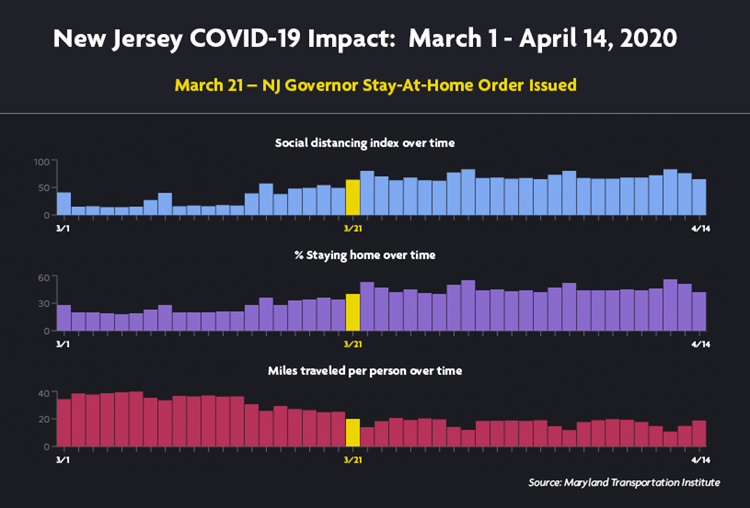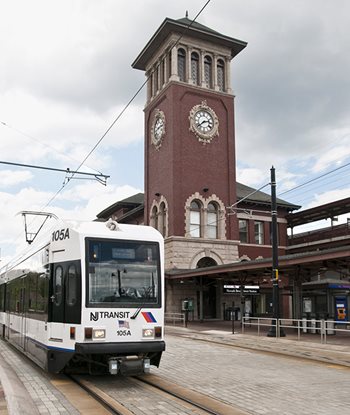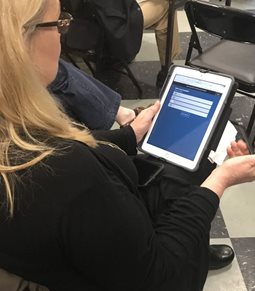April 2020
Posted: 4/22/2020 10:59:14 AM
On March 21, New Jersey Governor Phil Murphy issued a stay-at-home order for nearly all of the state's 9 million residents. In the week following, people took the order very seriously, with about 45 percent staying at home.
Analysis by the University of Maryland Transportation Institute indicates that New Jersey had the highest increase in the percentage of people staying at home during the week after a statewide order — a 13 percent increase from the previous week (the next highest were New York, Illinois and California at 11 percent).
The Institute’s ongoing analysis of nationwide travel behavior during the pandemic crisis draws on privacy-protected data from mobile devices, government agencies, health care systems, and other sources. An online interactive analysis tool provides a wealth of data about the travel impacts of the crisis. It is updated daily.
The analysis indicates that New Jersey residents are practicing a level of social distancing and travel reduction in keeping with the devastating impacts of the pandemic experienced here – second in the nation in COVID-19 fatalities. As of April 14, the state scored 65 on an index of social distancing compared to 52 for the nation overall. The index considers stay-at-home behavior and reduction in trips, among other factors.
The percentage of people in New Jersey staying at home increased from 34 percent in the week prior to the Governor’s announcement to 47 percent in the second week of April. Miles travel per person per day dropped 30 percent to 16.8 miles over the same period.

The three counties hardest hit by the illness – Bergen, Hudson and Essex – have stay-at-home rates over 50 percent. A county-by-county breakdown is compiled here .
The Maryland researchers find that nationwide there has been a lack of progress in getting more people to comply with social distancing and reduced travel.. A press release notes: “The percentage of people staying home nationwide increased from 20 percent to 35 percent at the onset of COVID-19 in mid-March but then stagnated at 35 percent for three weeks, despite skyrocketing new COVID-19 cases.”
Posted: 4/17/2020 9:04:52 AM
 Will the increase in telework continue? How will shifts in commuting affect public transportation and downtowns? Will there need to be a shift away from office space? It is possible to continue some of the positive environmental impacts — including cleaner air — after the pandemic ends?
Will the increase in telework continue? How will shifts in commuting affect public transportation and downtowns? Will there need to be a shift away from office space? It is possible to continue some of the positive environmental impacts — including cleaner air — after the pandemic ends?
These are just some of the questions members of the NJTPA’s Regional Transportation Advisory Committee (RTAC) posed during its April 13 meeting during a discussion on the NJTPA’s next Long Range Transportation Plan, which will have a horizon year of 2050.
When the coronavirus pandemic hit, work was well underway on the NJTPA’s next plan, which will serve as a vision for the region’s future. A lot of the “game changers” that were considered as part of the last long-range plan — climate change, autonomous vehicles, a need for adequate infrastructure funding — are still relevant today, but the pandemic has shifted the way we look at things.
“How we’re thinking about a lot of these things is very different,” said Lois Goldman, Director of Long Range Transportation Planning at the NJTPA. “Things like telework, things like complete streets and the big game changers obviously are the state of our economy and the things that this epidemic has highlighted in terms of equity and income disparities.”
More than 718,000 New Jersey residents have filed for unemployment benefits since mid-March. In the first week of the outbreak alone, the NJ Department of Labor said applications were up 1,600 percent. About half of the people seeking unemployment benefits have a high school diploma or lower level of education. In addition, about half of private sector employment in the state, or roughly 860,000 businesses, are small businesses, many of which are struggling to survive.
The next long-range plan must consider these factors and more. RTAC members questioned what the impact on downtowns might be. More people could move to downtowns because they are employment centers and essentials – like grocery stores – are often within walking distance. However, some people questioned if there could be a shift from cities to the suburbs where people have more space to socially distance themselves from others. Other issues that were raised include:
- Office space: Bigger offices would allow workers to have more space, or offices could shrink with more employees telecommuting. In some areas, it may be possible to convert office space into much-needed housing stock.
- Complete Streets: With fewer cars on the road, it may be possible to install more bicycle lanes and larger spaces for walking.
- Equity: It will be important to ensure adequate access to broadband, members noted. People should also have access to remote training and employment opportunities.
- Transportation Funding: With more fuel efficient and alternative fuel vehicles on the road, gas tax revenue was already declining. But now, with stay-at-home orders in place, the gas tax revenue has plummeted.
Goldman said the goal of the next long-range plan is to set the stage for a positive future that addresses some of the equity issues more deeply and helps make the economy stronger.
Posted: 4/9/2020 2:25:37 PM
 Along with much of the public sector, the NJTPA has been exploring ways to use virtual means to engage the public during the pandemic until in-person gatherings can resume. This includes researching innovative techniques used by agencies around the country, which the NJTPA and its city and county member agencies, and partners could use.
Along with much of the public sector, the NJTPA has been exploring ways to use virtual means to engage the public during the pandemic until in-person gatherings can resume. This includes researching innovative techniques used by agencies around the country, which the NJTPA and its city and county member agencies, and partners could use.
The findings were incorporated into a best practices document, which the NJTPA will be using to conduct outreach for its programs and studies. Anyone is welcome to use the Virtual Public Engagement Beset Practices document as a resource. It includes information on several different ways to gather public input virtually. This can include live or recorded presentations (such as webinars or livestreams), online surveys, comment forms, interactive maps and webpages with project information and key documents. Deciding which tools to use for a project really depends on the target audience.
It recommends doing fact finding first, including engaging local officials to find out where people go to get their information and taking stock of existing county/municipal websites, e-mail lists and social media accounts in the study area to ensure they will be effective. Community groups, chambers of commerce or other organizations can also be enlisted to disseminate information.
While the NJTPA will be using more online tools in the coming weeks and months, it remains committed to making public outreach inclusive and accessible. This includes ensuring project websites are mobile-friendly and may include mailing study information to residents in areas where there are pockets of people who do not have online access. The Virtual Public Engagement Best Practices document is available in the Public Involvement section of our website.